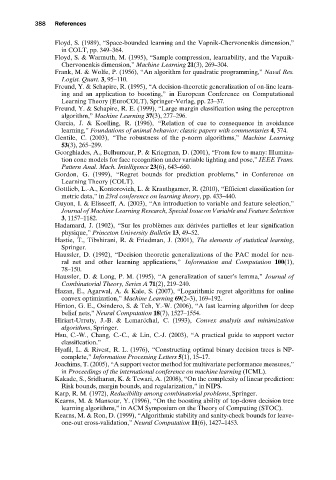Page 406 - Understanding Machine Learning
P. 406
References
388
Floyd, S. (1989), “Space-bounded learning and the Vapnik-Chervonenkis dimension,”
in COLT, pp. 349–364.
Floyd, S. & Warmuth, M. (1995), “Sample compression, learnability, and the Vapnik-
Chervonenkis dimension,” Machine Learning 21(3), 269–304.
Frank, M. & Wolfe, P. (1956), “An algorithm for quadratic programming,” Naval Res.
Logist. Quart. 3, 95–110.
Freund, Y. & Schapire, R. (1995), “A decision-theoretic generalization of on-line learn-
ing and an application to boosting,” in European Conference on Computational
Learning Theory (EuroCOLT), Springer-Verlag, pp. 23–37.
Freund, Y. & Schapire, R. E. (1999), “Large margin classification using the perceptron
algorithm,” Machine Learning 37(3), 277–296.
Garcia, J. & Koelling, R. (1996), “Relation of cue to consequence in avoidance
learning,” Foundations of animal behavior: classic papers with commentaries 4, 374.
Gentile, C. (2003), “The robustness of the p-norm algorithms,” Machine Learning
53(3), 265–299.
Georghiades, A., Belhumeur, P. & Kriegman, D. (2001), “From few to many: Illumina-
tion cone models for face recognition under variable lighting and pose,” IEEE Trans.
Pattern Anal. Mach. Intelligence 23(6), 643–660.
Gordon, G. (1999), “Regret bounds for prediction problems,” in Conference on
Learning Theory (COLT).
Gottlieb, L.-A., Kontorovich, L. & Krauthgamer, R. (2010), “Efficient classification for
metric data,” in 23rd conference on learning theory, pp. 433–440.
Guyon, I. & Elisseeff, A. (2003), “An introduction to variable and feature selection,”
Journal of Machine Learning Research, Special Issue on Variable and Feature Selection
3, 1157–1182.
Hadamard, J. (1902), “Sur les problèmes aux dérivées partielles et leur signification
physique,” Princeton University Bulletin 13, 49–52.
Hastie, T., Tibshirani, R. & Friedman, J. (2001), The elements of statistical learning,
Springer.
Haussler, D. (1992), “Decision theoretic generalizations of the PAC model for neu-
ral net and other learning applications,” Information and Computation 100(1),
78–150.
Haussler, D. & Long, P. M. (1995), “A generalization of sauer’s lemma,” Journal of
Combinatorial Theory, Series A 71(2), 219–240.
Hazan, E., Agarwal, A. & Kale, S. (2007), “Logarithmic regret algorithms for online
convex optimization,” Machine Learning 69(2–3), 169–192.
Hinton, G. E., Osindero, S. & Teh, Y.-W. (2006), “A fast learning algorithm for deep
belief nets,” Neural Computation 18(7), 1527–1554.
Hiriart-Urruty, J.-B. & Lemaréchal, C. (1993), Convex analysis and minimization
algorithms, Springer.
Hsu, C.-W., Chang, C.-C., & Lin, C.-J. (2003), “A practical guide to support vector
classification.”
Hyafil, L. & Rivest, R. L. (1976), “Constructing optimal binary decision trees is NP-
complete,” Information Processing Letters 5(1), 15–17.
Joachims, T. (2005), “A support vector method for multivariate performance measures,”
in Proceedings of the international conference on machine learning (ICML).
Kakade, S., Sridharan, K. & Tewari, A. (2008), “On the complexity of linear prediction:
Risk bounds, margin bounds, and regularization,” in NIPS.
Karp, R. M. (1972), Reducibility among combinatorial problems, Springer.
Kearns, M. & Mansour, Y. (1996), “On the boosting ability of top-down decision tree
learning algorithms,” in ACM Symposium on the Theory of Computing (STOC).
Kearns, M. & Ron, D. (1999), “Algorithmic stability and sanity-check bounds for leave-
one-out cross-validation,” Neural Computation 11(6), 1427–1453.

